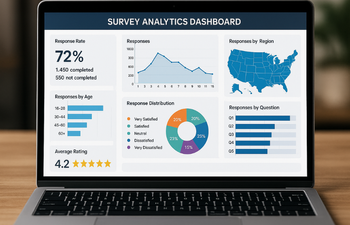How to Run Employee Engagement Surveys That Actually Work
Discover how to run employee engagement surveys that actually work, improve culture, and boost morale effectively.

Introduction
Employee engagement is more than just a buzzword, it's the lifeblood of a thriving organization. When done right, employee engagement surveys can reveal deep insights, uncover hidden frustrations, and point the way to stronger productivity and retention. But here’s the kicker: most companies get it wrong. They either ask the wrong questions, never act on the results, or lose trust with employees altogether.
This article explores how to run employee engagement surveys that actually work, with practical strategies, expert insights, and implementation tips that truly move the needle.
Why Employee Engagement Surveys Matter
Engaged employees are productive employees. They’re happier, more creative, and more committed. But without consistent, clear feedback mechanisms, companies risk becoming echo chambers where leadership is disconnected from the workforce’s reality.
Engagement surveys provide:
- Data-driven insights to guide leadership decisions
- Opportunities to improve culture and morale
- Early warnings for potential retention issues
- Clearer communication channels between staff and management
Designing Employee Engagement Surveys That Work
Creating effective surveys starts with clear goals. What are you trying to understand? Is it general satisfaction, leadership trust, or team collaboration? A laser-focused objective ensures meaningful data.
For tips on crafting questions people actually want to answer, see How to Write Survey Questions People Actually Want to Answer.
- Define the purpose (e.g., measure team morale, gauge leadership trust)
- Choose a format (annual, quarterly, pulse surveys)
- Decide on delivery (email, HR platform, mobile apps)
Don’t overcomplicate it. Simple, targeted surveys with a mix of multiple-choice, Likert scale, and open-ended questions work best.
Crafting Effective Survey Questions
Not all questions are created equal. The way you frame them impacts the answers you receive.
Use these categories for a balanced survey:
Avoid leading or vague questions. Every item should be unbiased, relevant, and actionable.
Ensuring Anonymity and Building Trust
Anonymity is a non-negotiable. If employees suspect that their responses can be traced, they’ll hold back or provide sugar-coated feedback.
Best practices:
- Use third-party platforms or anonymous forms
- Clearly communicate privacy protocols
- Refrain from collecting unnecessary identifiers (e.g., department, team size)
Trust is built not just through anonymous platforms but through transparent communication and consistent follow-up.
Choosing the Right Survey Frequency
Timing matters. Once-a-year surveys often come too late to fix cultural or performance issues. Instead, mix long annual surveys with shorter pulse surveys.
Let your people know how often you’ll ask for feedback and why.
Encouraging Participation with Clear Communication
The best-designed survey is worthless without strong participation. Transparency about the intent and value of the survey boosts completion rates.
Tips to maximize participation:
- Communicate the why behind the survey
- Reassure confidentiality
- Send reminders before the deadline
- Share past improvements based on feedback
Employees need to feel heard, not watched.
Analyzing Results with a Strategic Lens
Data without action is just noise. Break down responses by trends, outliers, and correlations. Use segmentation wisely (department-level insights) but cautiously to maintain anonymity.
Key focus areas:
- Patterns in disengagement
- Areas of strong performance
- Emerging themes in open responses
Use tools like Excel, Power BI, or specialized HR analytics platforms to visualize findings.
Turning Survey Data Into Actionable Steps
Here’s where most companies fail: no follow-through.
Once you’ve identified pain points and opportunities, prioritize them:
- What can we fix immediately?
- What needs longer-term strategy?
- What requires team input or workshops?
Don’t try to fix everything at once. Show progress over perfection.
Communicating Survey Results Transparently
Employees want closure. They’ve spoken, now they expect to be heard. Share a summary of key findings, themes, and your action plan.
Use town halls, newsletters, or manager briefings to communicate results, and allow space for employees to ask questions or suggest solutions.
Tracking Progress Over Time
Set KPIs tied to engagement goals. Measure before and after initiatives. Track progress on a quarterly basis to show trends and improvements.
Examples:
Celebrate wins, and re-evaluate what isn’t improving.
Leveraging Technology for Better Surveys
Digital tools can streamline the entire survey process. Look for platforms with customizable templates, anonymity features, and analytics dashboards.
Recommended tools:
- Culture Amp
- Glint
- Officevibe
- TINYpulse
- Qualtrics
Choose based on your company size, integration needs, and budget.
Using Employee Feedback to Shape Culture
Surveys are only one piece of the puzzle. Use feedback to shape onboarding, performance reviews, leadership training, and communication strategies.
When employees see their feedback influencing culture, engagement naturally rises.
Avoiding Common Mistakes in Survey Execution
Let’s face it, mistakes happen. But they’re avoidable if you’re aware.
If you're interested in common pitfalls that can ruin your survey response rate, check out 10 Survey Question Mistakes That Are Ruining Your Response Rate.
Common pitfalls:
- Asking too many questions
- Failing to follow up on results
- Using confusing or biased language
- Ignoring low participation rates
- Not aligning surveys with business goals
Awareness of these can save you both time and credibility.
Creating a Culture of Continuous Feedback
Employee surveys aren’t a one-and-done activity. Make them a consistent part of your communication rhythm.
Supplement formal surveys with:
- 1-on-1 check-ins
- Suggestion boxes
- Team retrospectives
- Anonymous chat channels
Make feedback feel natural, not forced.
The ROI of Employee Engagement Surveys
Think surveys are just “feel-good” activities? Think again.
Well-executed surveys can lead to:
Track these KPIs to justify continued investment in engagement efforts.
Final Thoughts on How to Run Employee Engagement Surveys That Actually Work
Running engagement surveys that genuinely work is more art than science. It requires listening, empathy, trust, and above all, action.
The most successful organizations don’t just collect feedback. They live it, breathe it, and evolve with it.
Start simple. Stay consistent. And always close the loop with your people.
Frequently Asked Questions
Find answers to the most common questions about this topic
They are tools used by organizations to gather feedback from employees about their satisfaction, motivation, and workplace experience.
At least once a year, but quarterly or pulse surveys offer more timely insights.
Include questions about satisfaction, communication, management support, development opportunities, and workplace culture.
Communicate its purpose, assure anonymity, and share results with follow-up actions to encourage trust.
Yes, anonymity promotes honest and transparent feedback from employees.
Analyze data, communicate findings with employees, and create an action plan to address concerns or build on strengths.









